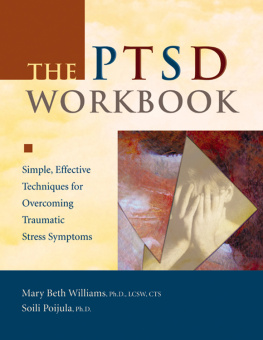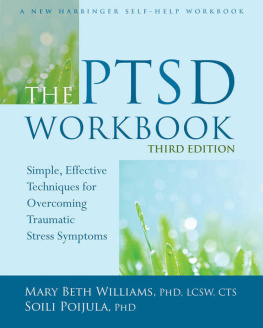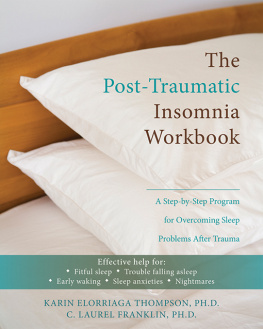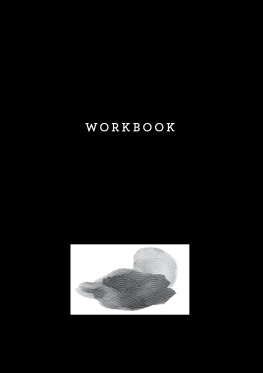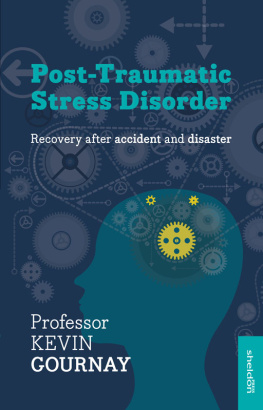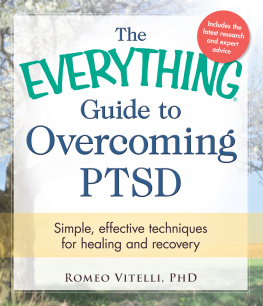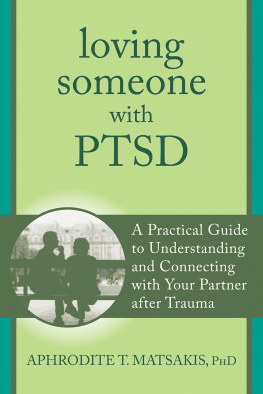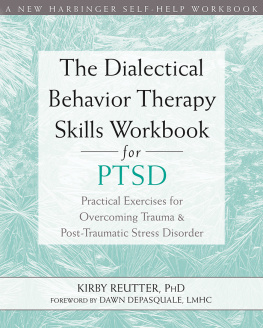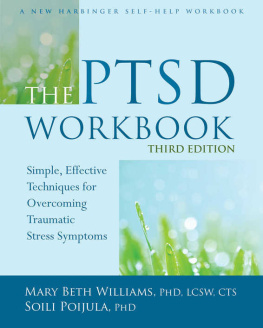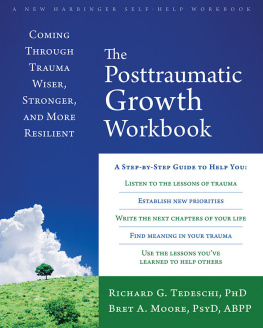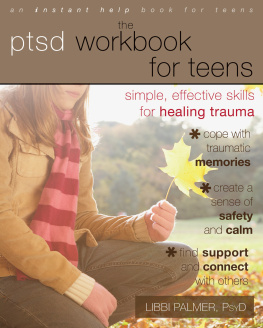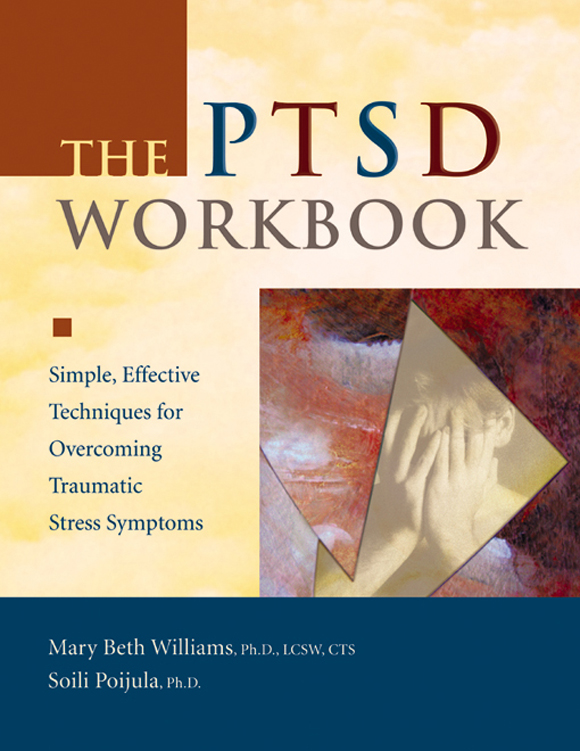
The PTSD Workbook
Simple, Effective Techniques for Overcoming Traumatic Stress Symptoms
Mary Beth Williams and Soili Poijula
New Harbinger Publications
Publishers Note
This publication is designed to provide accurate and authoritative information in regard to the subject matter covered. It is sold with the understanding that the publisher is not engaged in rendering psychological, financial, legal, or other professional services. If expert assistance or counseling is needed, the services of a competent professional should be sought.
Distributed in the U.S.A. by Publishers Group West; in Canada by Raincoast Books; in Great Britain by Airlift Book Company, Ltd.; in South Africa by Real Books, Ltd.; in Australia by Boobook; and in New Zealand by Tandem Press.
Diagnostic criteria for PTSD and Acute Stress Disorder adapted with permission from the Diagnostic and Statistical Manual of Mental Disorders, Fourth Edition, Text Revision. Copyright 2000 American Psychiatric Association.
Copyright 2002 by Mary Beth Williams and Soili Poijula
New Harbinger Publications, Inc.
5674 Shattuck Avenue
Oakland, CA 94609
Cover design by Lightbourne Images
Edited by Clancy Drake
Text design by Tracy Marie Powell-Carlson
ISBN: 1-57224-282-5 Paperback
ISBN: Epub
All Rights Reserved
New Harbinger Publications Web site address: www.newharbinger.com
I would like to dedicate this book to the families, friends, and colleagues of the victims of the terrorist attacks of September 11, 2001. I would also like to dedicate it to the numbers of responders and traumatologists who have provided services to those who have been traumatized by those events. This workbook is also dedicated to survivors of many other types of traumatic events as they travel their own healing paths.
Contents
Lets Roll
When this workbook was first conceptualized and was being written, life in the United States of America was moving along according to the rules of comprehensibility, security, and sameness. There was no hint of the destruction, and deathand the paradigm shiftthat would occur on September 11, 2001. Suddenly, life is not the same and never will be the same for thousands of families and the friends of those families; for thousands and thousands of rescue workers, crisis debriefers, firefighters, law enforcement officers, EMTs, and military personnel; and for the American nation as a whole. The illusion that most Americans had of invulnerability, that it could never happen here, is gone. Yet the American spirit is not gone. It may be shaken, but the words of Todd Beamer of Cranbury, New Jersey and United flight 93 have become the motto for many.
The horror of trauma that has been lifelong for many is now more familiar to others than it has ever been. As airplanes fly overhead and we look to the sky to make sure that they truly are flying and not crashing, Vietnam veterans express the sentiment, Welcome to our world. As child abuse survivors relate their reactions to the tragedies and hear the stories of the masses, they, too, say welcome to our world of terror.
As an American who is also a crisis intervenor, I have listened to the stories of many during the past few weeksfirefighters on the scene and off at the Pentagon; nurses who watched the collapse of the World Trade Center towers from the thirty-third floor of their own office building, unable to help or do anything to prevent the mass casualties. They spoke of their own flight down the thirty-three flights of stairs to the dust and debris that surrounded them. There were the stories of Arab, Muslim, and even Sikh and Hindu families who were afraid to leave their homes because of possible retaliation. Yet, in the midst of these stories are also the stories of persons who want to help. There is the story of one trauma survivor who made a sign that said Bless Our Fallen Heroes, covered it with plastic wrap, and took it to the local fire station in the dead of night. There is the story of another survivor who made 200 tricolor bows and handed them out at her church. There is the bank employee who organized a community-wide forum for her church so that others could hear messages about trauma and its impacts and about hope for healing.
It is my hope that this workbook will be helpful to many of those who have been traumatized by the horrors of September 11, 2001. Keeping Todd Beamers words in mind as a new motto for healing, Lets roll, and face the future as our ancestors did when they said, We have not yet begun to fight.
Mary Beth Williams, Ph.D., L.C.S.W. September 2001
Trauma survivors need to find ways to work through their experiences and get a sense of meaning and understanding is great. While the majority of those who have experienced direct trauma or who have witnessed trauma will heal, even persons who do not develop full-blown post-traumatic stress disorder, or PTSD, will experience a number of the symptoms of post-traumatic stress: flashbacks; intrusive thoughts and memories; hyper-reactivity; avoidance of persons, places, things, and other triggers; jumpiness; and other symptoms. Other persons have experienced lifelong traumas that are character changing; many of these people suffer from a syndrome that researchers are just beginning to describe, called complex PTSD. This workbook was conceptualized as a resource for the survivor who experiences a few or many of the symptoms of PTSD or complex PTSD.
When we were first asked to develop this book, we asked colleagues to share exercises that might help survivors do the work themselves. We also began to focus on the exercises we use in our own clinical work. Indeed, our clinical experience is what makes us qualified to author this book. Both of us are primarily grunt workers in the trenches of the field of trauma. We have met with many clients on a regular basis for both short-term and long-term therapy. That extensive experience allows us to say that though the road of healing may be long and difficult, healing can and does happen.
In this workbook, you will have the opportunity to complete numerous exercises that will give you insight into your symptoms, your beliefs, your behaviors, and your feelings about the trauma or traumas you endured. Many of these exercises can be completed in the book itself, so that the book becomes a record of your recovery from trauma as well as a resource for you to turn to again and again throughout that recovery. Other exercises can be completed in a separate notebook or journal, which can also be used to expand upon the exercises you complete in the book or to record your other thoughts and feelings along your journey to healing.
We hope that this book will help you on that journey.
What is trauma? What does it mean to survive it? To work through it? How many times have you thought that life was understandable and was going along smoothly when something happened to change its entire course? One morning you wake up and the sun is shining, or drizzle is falling around you, and you feel love. However, three hours later, nothing is the same. Maybe it is because of a conversation; maybe there is a car accident that kills someone you love. Maybe a tornado swoops down and changes everything. Everything. There you are, hanging on the edge of a precipice. What do you do? Do you quit? Do you run away? Do you decide you want to just die and not face it anymore? Do you even want to go on?
Prior to the occurrence of a traumatic event or events, there are generally certain basic assumptions that guide your life. You probably believe that the world is kind, that there is meaning to your life, and that things make sense. You believe that you are good and worthy of having good things happen to you (Janoff-Bulman 1992). Then trauma strikes. You are suddenly no longer in control of what has happened around you. Youre vulnerable and your world is no longer safe and secure. Furthermore, you cant make sense of what is left over. The meaning of life that was present just a short time before is gone. Life is no longer fair and just.
Next page
